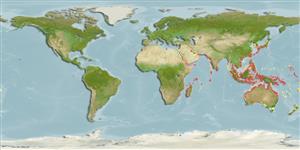Common names from other countries
>
Gobiiformes (Gobies) >
Gobiidae (Gobies) > Amblyopinae
Etymology: Paratrypauchen: The generic name is derived from the Greek Para, meaning beside or near, alluding to the similarity with Trypauchen. The gender is masculine..
More on author: Bleeker.
Environment: milieu / climate zone / depth range / distribution range
Οικολογία
Θαλασσινό(ά); Υφάλμυρο βενθικό(ς); εύρος βάθους 0 - 10 m (Ref. 86942). Tropical
Indo-West Pacific: Natal to Kenya, through India, Indonesia to the Philippines. Also known from Wakayama, Niigata and Kumamoto Prefecture (Japan), the Korean Peninsula, China, and Malaysia (Ref. 559). Also from Singapore, Mozambique (Ref. 92840).
Μέγεθος / Βάρος / Age
Maturity: Lm ? range ? - ? cm
Max length : 18.0 cm TL αρσενικό/απροσδιόριστο; (Ref. 4343)
Short description
Κλείδες προσδιορισμού | Μορφολογία | Μορφομετρία
Ραχιαίες άκανθες (συνολικά) : 6; Μαλακές ραχιαίες ακτίνες (συνολικά) : 48 - 51; Εδρικές άκανθες: 0; Μαλακές εδρικές ακτίνες: 45 - 47.
Inhabits soft mud bottoms, river mouths areas near mangrove forests; omnivore feeding on benthic invertebrates like crustaceans (Ref. 92840). Burrows in mud or shingle areas in inshore and estuarine waters (Ref. 4343, 11230).
Life cycle and mating behavior
Maturities | Αναπαραγωγή | Spawnings | Egg(s) | Fecundities | Προνύμφες
Maugé, L.A., 1986. Gobiidae. p. 358-388. In J. Daget, J.-P. Gosse and D.F.E. Thys van den Audenaerde (eds.) Check-list of the freshwater fishes of Africa (CLOFFA). ISNB, Brussels; MRAC, Tervuren; and ORSTOM, Paris. Vol. 2. (Ref. 4343)
IUCN Red List Status (Ref. 130435)
CITES (Ref. 128078)
Not Evaluated
Threat to humans
Harmless
Human uses
αλιεία: περιορισμένης εμπορικότητας; Ενυδρείο: Εμπορικό(ά)
Εργαλεία
Special reports
Download XML
Διαδικτυακές πηγές
Estimates based on models
Preferred temperature (Ref.
115969): 23.6 - 29.2, mean 28.4 (based on 2768 cells).
Phylogenetic diversity index (Ref.
82804): PD
50 = 1.0000 [Uniqueness, from 0.5 = low to 2.0 = high].
Bayesian length-weight: a=0.00417 (0.00263 - 0.00661), b=2.90 (2.77 - 3.03), in cm Total Length, based on LWR estimates for this species & (Sub)family-body (Ref.
93245).
Τροφικό Επίπεδο (Ref.
69278): 3.7 ±0.4 se; based on size and trophs of closest relatives
Ελαστικότητα (Ref.
120179): Μεσαίο(α), ελάχιστος χρόνος για διπλασιασμό πληθυσμού 1,4 - 4,4 έτη (Preliminary K or Fecundity.).
Fishing Vulnerability (Ref.
59153): Low vulnerability (10 of 100).
